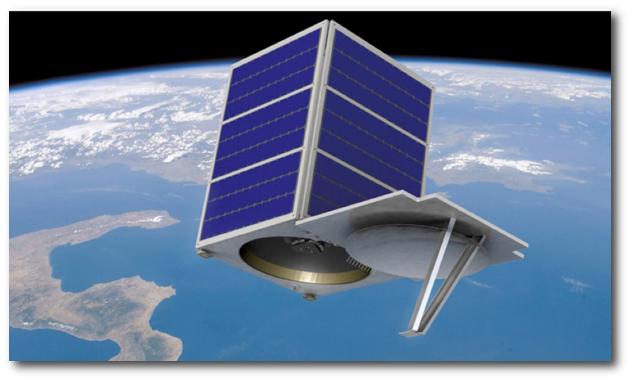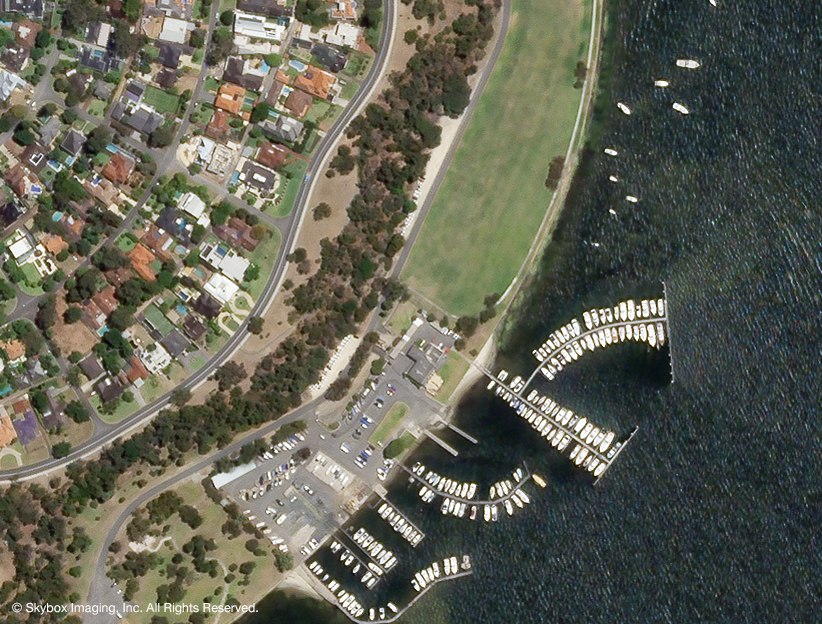HD video from a private satellite SkySat
California startup SkyBox has posted a high-resolution video shot by their first spacecraft.
Satellite SkySat-1 launched a rocket "Dnepr" November 21, 2013. A month later, SkyBox published several high-resolution images and a full-fledged video taken from orbit (with the exception of the ISS, this shooting seems to be the first time):
(Expand to full screen)
At first glance, it seems that the satellite is hanging above one point during the shooting, but this is not so. The spacecraft moves in a weakly elliptical polar solar-synchronous orbit at an average altitude of about 600 km. The trick of the video is that the camera "captures" a certain piece of terrain and "leads" it during the flight. This can be seen in the changing angle of view of tall buildings at 0: 37-0: 46. This shooting technique limits video recording time to 90 seconds. But this is enough, for example, to determine the speed of traffic on the roads or shipping.
')
SkyBox Imagin was founded by four graduate students at Stanford University. They wrote a business plan for creating a group of low-resolution, low-resolution remote sensing satellites in 2009, and by mid-summer they received the first investment of $ 3 million. This allowed the company to start working, a year later they held a second round, at which they were able to attract $ 18 million dollars. Finally, in April 2012, another $ 70 million dollars was invested in them. And this is despite the fact that they, as a company, have not launched a single spacecraft yet.

Despite the seemingly dynamic capital gains, they spent a lot of effort searching for an investor to implement their idea. Financiers were afraid of a repetition of the history of the early 2000s, which occurred with satellite telephony. Companies like Iridium or Inmarsat showed great promise, but as a result, they messed up their cellular networks.
By 2013, SkyBox Imagin created two of the same type of spacecraft SkySat-1 and SkySat-2. They are distinguished by a compact minimalist design, the absence of disclosed solar panels. The telescope cover is also a panel for placing the radio antenna:



The developers assumed that the first device will be ready by the end of 2012, but the dates have shifted by a year. The launch of a pair of satellites was planned for December 2013 with the Soyuz-2.1B rocket, along with the Russian device Meteor-M No. 2 (they also fly our satellite DX1). However, the start is constantly postponed, at first it was postponed to February, now to March, and the possibility of further changes is not excluded. Therefore, Californians did not wait, and the first SkySat was sent by Dnipro in November.
The first images confirmed the claimed characteristics of the devices, and demonstrated high quality data:

Nice, Cote d'Azur.

Perth. Australia.

Perth. Australia.
Satellites are filmed in several spectral ranges. Panchromatic shooting provides details up to 90 cm per pixel. Multispectral (red, blue, green, near infrared) - up to 2 meters per pixel.
The company's plans include the launch of 24 satellites that will be able to survey any given part of the Earth every 8 hours.
The only detail that the developers are silent about is the capacity of the radio link. You can remove and save the data on board for a long time, but it is more difficult to drop it to the Earth. The truth is that the processing of photos and videos made right on board. Therefore, probably, after processing and compression, the information will become much more accessible, and the matter remains only for a sufficient number of receiving stations. In addition, immediately remove the entire Earth is not required. It is enough to focus on large cities, pictures of which will be in high demand.
The business strategy of SkyBox is based on the ideas of “Earth remote sensing 2.0”, according to which the demand for space imagery will be determined by the interests of private users, not states or large companies. "Specify the time and place of shooting, and enter your credit card number" - say the company representatives. They expect to repeat the experience of GPS, which was not popular when restrictions were imposed on signals. When the restrictions were removed, the navigators quickly captured the whole world.
Well-known space businessman and investor Peter Diamandis speaks about the big prospects of satellite imagery:
In fact, the need for spy satellites simply disappears. Everything goes to the fact that everyone becomes his own spy. Want to find Noah's Ark on Mount Ararat? Flying saucer on the secret base of the US Air Force? Free parking space for two blocks? Prepare a credit card. The mentioned limit of 0.5 meters will not allow to follow people, but the car is more difficult to hide.
It is worth saying that the economic viability of SkyBox Imagin has not yet been confirmed. Experts say that the performance of this scheme will be confirmed only when there are 12 SkySat in orbit, what to wait for a few more years.
Satellite SkySat-1 launched a rocket "Dnepr" November 21, 2013. A month later, SkyBox published several high-resolution images and a full-fledged video taken from orbit (with the exception of the ISS, this shooting seems to be the first time):
(Expand to full screen)
At first glance, it seems that the satellite is hanging above one point during the shooting, but this is not so. The spacecraft moves in a weakly elliptical polar solar-synchronous orbit at an average altitude of about 600 km. The trick of the video is that the camera "captures" a certain piece of terrain and "leads" it during the flight. This can be seen in the changing angle of view of tall buildings at 0: 37-0: 46. This shooting technique limits video recording time to 90 seconds. But this is enough, for example, to determine the speed of traffic on the roads or shipping.
')
SkyBox Imagin was founded by four graduate students at Stanford University. They wrote a business plan for creating a group of low-resolution, low-resolution remote sensing satellites in 2009, and by mid-summer they received the first investment of $ 3 million. This allowed the company to start working, a year later they held a second round, at which they were able to attract $ 18 million dollars. Finally, in April 2012, another $ 70 million dollars was invested in them. And this is despite the fact that they, as a company, have not launched a single spacecraft yet.

Despite the seemingly dynamic capital gains, they spent a lot of effort searching for an investor to implement their idea. Financiers were afraid of a repetition of the history of the early 2000s, which occurred with satellite telephony. Companies like Iridium or Inmarsat showed great promise, but as a result, they messed up their cellular networks.
By 2013, SkyBox Imagin created two of the same type of spacecraft SkySat-1 and SkySat-2. They are distinguished by a compact minimalist design, the absence of disclosed solar panels. The telescope cover is also a panel for placing the radio antenna:



The developers assumed that the first device will be ready by the end of 2012, but the dates have shifted by a year. The launch of a pair of satellites was planned for December 2013 with the Soyuz-2.1B rocket, along with the Russian device Meteor-M No. 2 (they also fly our satellite DX1). However, the start is constantly postponed, at first it was postponed to February, now to March, and the possibility of further changes is not excluded. Therefore, Californians did not wait, and the first SkySat was sent by Dnipro in November.
The first images confirmed the claimed characteristics of the devices, and demonstrated high quality data:

Nice, Cote d'Azur.

Perth. Australia.

Perth. Australia.
Satellites are filmed in several spectral ranges. Panchromatic shooting provides details up to 90 cm per pixel. Multispectral (red, blue, green, near infrared) - up to 2 meters per pixel.
The company's plans include the launch of 24 satellites that will be able to survey any given part of the Earth every 8 hours.
The only detail that the developers are silent about is the capacity of the radio link. You can remove and save the data on board for a long time, but it is more difficult to drop it to the Earth. The truth is that the processing of photos and videos made right on board. Therefore, probably, after processing and compression, the information will become much more accessible, and the matter remains only for a sufficient number of receiving stations. In addition, immediately remove the entire Earth is not required. It is enough to focus on large cities, pictures of which will be in high demand.
The business strategy of SkyBox is based on the ideas of “Earth remote sensing 2.0”, according to which the demand for space imagery will be determined by the interests of private users, not states or large companies. "Specify the time and place of shooting, and enter your credit card number" - say the company representatives. They expect to repeat the experience of GPS, which was not popular when restrictions were imposed on signals. When the restrictions were removed, the navigators quickly captured the whole world.
Well-known space businessman and investor Peter Diamandis speaks about the big prospects of satellite imagery:
In fact, the need for spy satellites simply disappears. Everything goes to the fact that everyone becomes his own spy. Want to find Noah's Ark on Mount Ararat? Flying saucer on the secret base of the US Air Force? Free parking space for two blocks? Prepare a credit card. The mentioned limit of 0.5 meters will not allow to follow people, but the car is more difficult to hide.
It is worth saying that the economic viability of SkyBox Imagin has not yet been confirmed. Experts say that the performance of this scheme will be confirmed only when there are 12 SkySat in orbit, what to wait for a few more years.
Source: https://habr.com/ru/post/207744/
All Articles